
|
|

|
The DaVinci Code
(2006)
Director Ron Howard's much-anticipated, big-screen religious conspiracy thriller with the tagline "Seek the Truth" was faithfully based upon Dan Brown's best-selling fictional book in 2003. The alternate religious idea that Jesus and Mary Magdalene married and had kids infuriated many religious groups. In some countries (such as Egypt), the film was banned. And a high-ranking Vatican archbishop called for a boycott. Several Catholic and Opus Dei groups (portrayed as a murderous cult), as well as conservative Christian groups, called for a boycott, mostly during the making of the film and during initial screenings, accusing it of blasphemy. The film was also accused of being ludicrous, inaccurate and unhistorical with far too many plot twists. One item that appeared fabricated was the existence of an ancient secret society called the Priory of Sion, which was actually created in 1956 by a man named Pierre Plantard. The main criticism of the film was that it unfairly mixed real historical fact into a fictional narrative. Even albinos were offended by the film, and lobbied for changes to the way the film portrayed them. Yet the tedious film was received lukewarmly as a convoluted, flat and stultified bore, although some liked the thriller aspects of the film. On a budget of $125 million, the film made $217.5 million (domestic). One major point of contention in the film was the question of who was sitting on Jesus' right hand side in DaVinci's The Last Supper painting - was it the beardless, effeminate long-haired Apostle John or Mary Magdalene, whom Jesus intended to take over the leadership of the church? Also, there was no holy grail or chalice on the table in the painting. Another debatable item was the idea that Jesus, usually thought to be celibate, married Mary Magdalene, who witnessed his crucifixion - and was pregnant at the time, and that she bore a daughter named Sarah who survived in France and created a bloodline. One of the non-canonical gospels, the Gospel of Philip, referred to Mary Magdalene as Jesus' "companion" or spouse - possibly meaning his wife. She was supposed to carry on his Church, an idea that would be heretical and threatening to the established church. The film's complex plot opened with the discovery of the murder of the Louvre Museum's elderly curator Jacques Sauniere (Jean-Pierre Marielle) and Priory of Sion Grand Master (the last living protector of holy artifact secrets), in the Parisian museum. He was shot in the abdomen and bled to death - the man's naked body, in a revealing pose, was found with a pentacle symbol (a symbol for the female goddess Venus) that he had etched into his own bloody chest and an enigmatic encrypted code written in blood, ending with P.S. Find Robert Langdon. The numerical sequence was a security code password for a bank vault and also provided other clues. He was posed like Leonardo da Vinci's famous drawing of the Vitruvian Man.
Religious symbologist and Harvard professor Robert Langdon (Tom Hanks), guest-lecturing in town, was called to the crime scene, and unbeknownst to him, was considered the prime suspect by police Captain Bezu Fache (Jean Reno) and Lieut. Collet (Etienne Chicot). French police cryptologist Sophie Neveu (Audrey Tautou), actually Sauniere's estranged granddaughter, tipped Langdon off that he was "in grave danger," and the two fled. Information provided in clues by Sauniere led the wrongly-accused murder suspect Langdon and Sophie through a byzantine trail of clues through France and England and ultimately to Scotland -- to a millenarian goddess-worshipping secretive sect called The Priory of Sion. The group espoused heretical theories about the marriage of a mortal Jesus Christ with Mary Magdalene who fathered a child - the real Holy Grail was not a chalice-cup, which did not appear in DaVinci's The Last Supper painting, but a royal bloodline! Their investigation was to explore the theory that Jesus' relatives were still living. Along the way, they met with crippled, obsessed Grail scholar Sir Leigh Teabing (Ian McKellen), who revealed new findings about the Holy Grail, and DaVinci's master work The Last Supper
The search led Sophie and Langdon to knowledge of the Priory's centuries-old battle with the clandestine Catholic sect Opus Dei regarding the group's 2,000 year old conspiracy to hush blasphemous information about Jesus' mortality and celibacy. The trail led to London's mythical Temple Church (where a group of Templars Knights were believed to be buried), Sir Isaac Newton's tomb at Westminster Abbey, and the Rosslyn Chapel in Scotland. In the basement of the chapel was a trap door stairway, leading to the location where Mary Magdalene's remains (in a sarcophagus) had been kept at one time. In the last portion of the film, Sophie was revealed as the current living descendant of Jesus and Mary Magdalene, protected by the Priory of Sion. Langdon declared: "Princess Sophie, you are the heir. The end of the bloodline. You are the last living descendant of Jesus Christ." At Rosslyn, members of the Priory of Scion, guardians or keepers (and friends of Sauniere), recognized Sophie as the heir. She was introduced to her grandmother. She learned that when Sauniere died, he took the location of Mary's sarcophagus with him to his death. There was no empirical proof that she was the heir, however. Langdon emphasized to her: "The only thing that matters is what you believe." In the final scene, Langdon was inspired by a blood-line pattern in his sink, after cutting himself shaving in his hotel room. He followed the Rose Line (prime meridian line) back to the Louvre's striking outdoor pyramidal structure itself. The camera spiraled downward to the sarcophagus of Mary Magdalene which appeared to be located in a chamber underneath where the two triangular pyramids (the Blade-male-upright pyramid, and the Chalice-female-inverted pyramid) geometrically-echoed each other. |
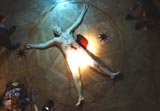 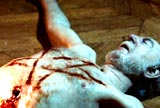 Murdered Louvre Museum Curator  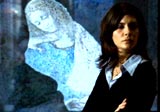 French Cryptologist Sophie Neveu (Audrey Tautou)  Bishop Aringarosa (Alfred Molina) 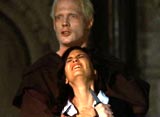 Albino Killer Silas (Paul Bettany) Holding Sophie 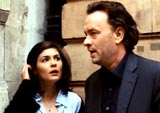 Sophie with Robert Langdon (Tom Hanks)  Arrest of Sir Leigh Teabing (Ian McKellen) - The Teacher 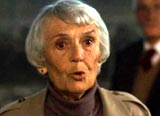 Sophie's Grandmother 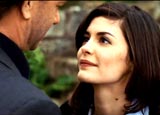 "You are the Heir"  Blood Line Pattern in Sink 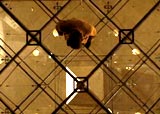 The Louvre's Pyramidal Sructure  The Discovery of the Hidden Sarcophagus Under the Louvre |
||||||||||||

|
Shortbus (2006)
Writer/director John Cameron Mitchell (director of the cult classic Hedwig and the Angry Inch (2001)) brought out his second arthouse feature film titled Shortbus (aka "The Sex Film Project"). It was screened both at the Cannes Film Festival, and at the Toronto International Film Festival. It was the "most explicit" or sexually-graphic film ever screened. It also had the widest release of any film showing unsimulated sex. This highly controversial film - named for the underground Brooklyn sex salon ("for the gifted and challenged") in the unrated film, contained many unsimulated, hardcore images of sexual intercourse (gay and straight), masturbation, ejaculation, a dominatrix sex whipping, an orgy scene and a gay menage a trois scene (with oral sex) accompanied by a rousing singing of the national anthem: "The Star Spangled Banner." The sex was encased within a non-pornographic dramatic narrative about emotionally-challenged post 9/11 New Yorkers searching for sexual happiness and self-discovery. The opening sequence - which cross-cut between three scenes - set the tone. Gay man and ex-prostitute James (Paul Dawson) in a bathtub filmed his genitals (while peeing into the water) with a hand-held video camera. [Spoiler: He was making a video suicide note.] Then, he performed a yoga-like backwards flip, with his penis suspended above his mouth - and attempted oral sex on himself. (A peeping tom stalker named Caleb (Peter Stickles) was photographing him from an across-the-street window.) In another NYC apartment, a costumed, spike-haired dominatrix (also an aspiring artist) named Severin (Lindsay Beamish) was whipping one of her male clients as he masturbated on a bed. In a third residence, Sofia (Sook-Yin Lee, host of CBC Radio's Definitely Not the Opera), a married couples sex counselor, was having "incredible" sex on a piano with her husband Rob (Raphael Barker), and then trying multiple positions on their bed and throughout their living areas. All of the males orgasmed at the same time - one onto the paint drippings of a Jackson Pollock painting.
Sofia told her husband that one of her patients named Cheryl (Miriam Shor) was urged to continue faking orgasms with her male partner Brad (Justin Hagan): "It's a completely legitimate strategy to buy time...An orgasm isn't something Brad can give her. She has to claim it for herself." In fact, Sofia was speaking about herself - she finally admitted that she was pre-orgasmic ("I never had one") during one of her counseling sessions with James and his male partner Jamie (PJ DeBoy), an ex-child star. The film's characters, Sofia, Severin, Rob, and James (among others) met regularly in the Brooklyn sex salon (titled Shortbus). There were a number of interlocking relationships that developed:
The film's conclusion occurred during a blackout in the city, happening simultaneously when Sofia was again unable to reach orgasm. At the Shortbus club during the rousing singing of "In the End" by the cross-dressing Mistress (Justin Vivian Bond) of the club, Sofia became excitedly engaged in a kissing and sexual threesome with another couple: Nick (Jan Hilmer) and Leah (Shanti Carson). As she finally achieved orgasm, the lights of the city were simultaneously restored.
|
  James (Paul Dawson)  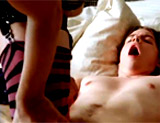 Severin (Lindsay Beamish) with client 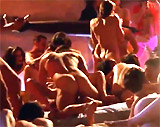   Activities At Shortbus  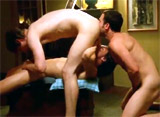 A Gay Threesome  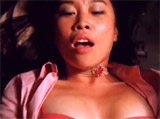 Sofia - Self-Stimulation |
||||||||||||

|
United 93 (2006)
This R-rated chillingly-realistic, unflinching, emotionally-moving ultra-verite docu-drama by British writer/director Paul Greengrass told the courageous and tragic story of heroic crew members and passengers on United's Flight 93 (flying from Newark NJ to San Francisco), the fourth hijacked plane on September 11, 2001. They were able to thwart the terrorists and prevent the plane from reaching its intended target - but instead crashed into a field in western Pennsylvania. The film was made all the more real by including some of the actual FAA ground crew and military officers involved in the actual event as cast members, and by retelling the tale in real-time. Necessarily containing intense and frightening sequences of terror and violence, the film (although precisely told and respectfully treating its subject matter without editorializing, theories, stereotypical human interest stories or personal dramas, or flag-waving politics) was criticized for its trailer that made the film appear different than it actually was -- as a conventional thriller. Others wondered whether it was "too soon" after the event (on the 5th year anniversary) for US audiences to view - and varying opinions contributed to the emotional debate. Universal also received criticism that it was exploiting a national tragedy, although others felt it was important to help remember and be inspired by the shattering event. |
 Chaos Aboard United 93 |
||||||||||||

|
Hounddog (2007)
Writer/director Deborah Kampmeier's exploitative and solemn Southern drama was heralded by its own controversial pre-release publicity. On July 21, 2006, the day the film wrapped its shooting, reports of the scandalous rape scene of a 12 year-old actress in the film were released. The same kinds of accusations brought against it recalled the uproar over other controversial films about exploiting a barely pubescent actress, such as Brooke Shields in Pretty Baby (1978), or Dominique Swain in the remake of Lolita (1997). This worn-out movie's tagline seemed appropriate:
Due to the clamor over the allegedly graphic rape scene, and other complaints about the sexualizing of a minor character, the film was re-edited (sanitized). Even before the film had been viewed, child advocates and the Catholic League called for a federal investigation to determine if any child pornography laws were broken during the making of the film. Petitions created online called for the arrest of Fanning's agent and mother and attempted to block the film's distribution. At the Sundance Film Festival where the film premiered, representatives of the Rape Abuse and Incest National Network (RAINN) went on stage and delivered an horrendous statistic - eight children under age 12 had been sexually assaulted in the time it took the audience to watch the film. The gothic-tinged, coming-of-age story set in the 1950s American South (in a small town in Alabama) told about a young, precocious, and thin tomboyish heroine Lewellen (Dakota Fanning) lacking a mother and suffering from an abusive childhood in a shack-home. She was being 'cared for' by both her stern, Bible-carrying, whiskey-swigging grandmother (Piper Laurie, reprising her scary role from the horror film Carrie (1976)) and her unstable, slovenly and brutish father Lou (David Morse), who was currently involved with sexy and battered girlfriend Ellen (or "Stranger Lady") (Robin Wright Penn) (later revealed to be Lewellen's aunt). In the first scene, young Lewellen (often seen in underwear throughout the film, exhibiting herself) offered a kiss to her best friend and swimming hole companion Buddy (Cody Hanford), in exchange for seeing his private parts (off-screen). Most of the time, she fantasized about her favorite singer Elvis Presley (famous for the song Hounddog), and brought beers to her drunken father (who became crazed and feeble-minded after being struck by lightning on a tractor during a storm). The film's most infamous and disturbing scene (heavily edited and shortened to be respectful, and appearing severely truncated, without any nudity or explicitness) was less than a minute in length. She was coaxed into impersonating her idol while naked (her "Elvis dance" to Hounddog complete with swinging hips and a low singing voice), in order to procure tickets to an Elvis concert from an older teenaged Wooden's Boy (Christoph Sanders), a milkman. She was raped in an abandoned, broken-down shed by the river where she had been lured by friend and intermediary Buddy, who passively watched (and then covered his eyes).
The very shadowy and dark scene showed only closeups of Lewellen's terrified face as the older teen boy unzipped his pants ("I got a thing about you"), and she begged: "Please, can I have my ticket now....I just want my ticket, please!" As the rape occurrred, Lewellen's tensed hand gripped an exposed nail and caused bleeding. Afterwards, she looked up at the hole in the roof of the shack, as water dripped in. Some accused the film of being entirely listless since the intensity of the rape scene was so completely softened. |
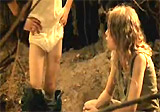  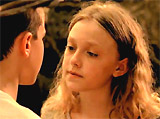 Lewellen (Dakota Fanning) with Friend Buddy (Cody Hanford) 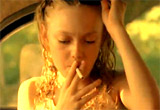 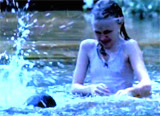 Lewellen Smoking and Swimming |
||||||||||||
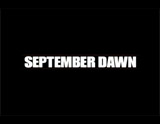
|
September Dawn (2007)
The backdrop of this independent film immediately brought about controversy about its historical story, wrapped within a fictionalized Romeo and Juliet romantic subplot:
The histrionic melodrama told about the infamous September 11, 1857 Mountain Meadows Massacre in which about 120 California-bound settlers in the Baker-Fancher party (Gentiles or non-Mormons, composed of men, women and children) were brutally murdered by Utah Mormons in an unspoiled valley in the Utah Territory. According to the tale, some wagon-train members were suspected of supporting gambling (with racehorses), and possibly some of the migrant-settlers were from Missouri where revered Mormon leader Joseph Smith had been persecuted. It was reportedly based on the official 27-page confession of convicted (and executed 20 years later by a firing squad) renegade Mormon John D. Lee (Jon Gries), the adopted son of LDS church leader Brigham Young (Terence Stamp). Conveniently, the massacre - that occurred on September 11th - helped the story draw close parallels to Islamic fundamentalist terrorism in modern times. The film's poster asked the main puzzling question:
It has been disputed whether the slaughter was specifically ordered by the LDS church leader Brigham Young or not, but the church has admitted that a group of religiously-zealous Mormon militia (with the help of local Native Americans - the Paiutes) DID lead the massacre in southern Utah Territory. In the film, Brigham Young implicitly spoke out and demanded an oath of silence regarding his murderous orders.
As with many other controversial films, the angered LDS church didn't preview the film, but instead issued a statement (with their version of the historical event) calling the film a "serious distortion of history." It believed that the film, a simplified good vs. evil treatise, was a piece of anti-Mormon propaganda and not historical truth-telling. |
 Bishop Jacob Samuelson (Jon Voight) 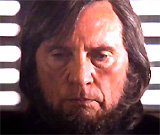 Brigham Young (Terence Stamp) |
||||||||||||
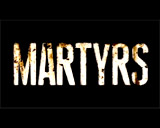
|
Martyrs (2008, Fr./Can.)
Writer/director Pascal Laugier's controversial, unrated, gory, nihilistic horror film was accused of being one of the most violent movies ever made. It was similar to the graphic, torture-porn film franchises in the US begun with Saw (2004) and Hostel (2005), although more compelling with greater intellectual significance. When the divisive film debuted at the Cannes Film Festival in 2008, it caused many audience members to walk out. The final 15 minutes of the unpleasant film was considered unflinchingly horrendous in its portrayal of cruelty. The plot was a brutal tale about two abused young females, who developed a close friendship with one another after being placed in an orphanage together:
Fifteen years later in 1986, crazed 25 year-old Lucie Jurin (Mylène Jampanoï as adult) came upon an isolated house and savagely, cold-bloodedly murdered with a shotgun an entire middle-class French family - the Belfonds (the two teens Marie and Antoine, and Mr. Belfond and his wife Gabrielle). Afterwards, she phoned Anna Assaoui (Morjana Alaoui as adult) and told her that she had vengefully killed her tormenting, sadistic captors from years earlier. Lucie continued to be haunted and terrorized by an imagined ghoulish, masochistic "Creature" (Isabelle Chasse) - a scarred, filthy, emaciated, stringy long-haired female who caused flesh wounds. The Creature returned and the suicidal Lucie slit her own arms with a razor blade, jumped through a glass window, and ripped open her own throat with a box-cutter - giving her peace when she died in Anna's arms in the pouring rain. Anna then discovered stairs behind a cabinet in the Belfond house, leading to an underground chamber. Pictures of female torture victims (martyrs) lined the corridor of the laboratory. Down another trap door, she found where the imprisoned 'Creature' was chained up - she came upon the tortured woman with scars and a metal blindfold contraption nailed to her head. Anna brought her up into the house, gave her a bath, and attempted to painfully remove the steel bolts from the blindfold. Strangers dressed in black arrived and shot the raving, maniacal 'Creature,' then took Anna as their new prisoner. Anna was introduced to the depraved leader of a secret torture society - elderly Mademoiselle (Catherine Bégin), who believed that the quasi-religious group could learn the secrets of the afterlife from tortured and suffering young women, although most-times, they frustratingly only created victims. After a long period of torture and degradation, most subjects would "see things that don't exist" such as creatures, monsters, or cockroaches. Anna was chained up in the same concrete cell where she had found the 'Creature.' She was force-fed greenish slop, slapped, and regularly brutalized. Her hair was cut and she was sponge-bathed. Eventually she submitted without resistance, and began hearing voices: "You're not scared anymore."
For the final stage of her suffering, in the film's last horrific 15 minutes, Anna was dragged away, clamped down to a steel medical gurney, and her skin from her entire body (except for her face) was flayed by a surgeon while she was alive - this caused her to achieve transfiguration. The members of the secret society were summoned to the house to learn of Anna's "authentic martyrdom" on the previous day. She was praised as being only the 4th individual in 17 years to have attained the stage of martyrdom, and the first to relate what she had seen. She had experienced a state of ecstasy lasting 2 hours and 15 minutes. Although still alive, she was now no longer communicating. The society's leader Mademoiselle was planning to reveal Anna's testimony to an assembled group - about what Anna had related to her about the secrets of the afterlife (what "lay beyond death") by whispering in her ear. Mademoiselle asked her assistant Etienne (Jean-Marie Moncelet) about the indescribable: "Could you imagine what there is after death?...Could you?" The Mademoiselle responded with her last words: "Keep doubting" - before abruptly committing suicide by shooting herself in the mouth. The film ended abruptly, with the definition of "martyr" - "noun, from the Greek 'marturos': witness." |
 Lucie's Murder of Her Tormentors - the Belfond Family  Haunting "Creature" 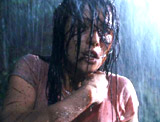 Lucie's Suicidal Death in Anna's Arms 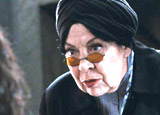 Mademoiselle (Catherine Bégin) 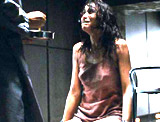 Newly-Captive Anna 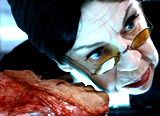 Barely-Alive Anna Whispering Secrets of Afterlife into Mademoiselle's Ear 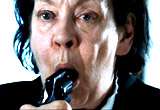
Mademoiselle's Suicide |
||||||||||||

|
Antichrist (2009, Denmark)
Outrageous Danish director Lars von Trier's controversial, compelling, nihilistic psychological-horror film (with only two characters) portrayed the tortured pain of a grieving, devastated, and unhinged mother. Although approaching the levels of violent torture-porn (filmed most explicitly with professional porn stars) seen in films like Saw (2004), there was also a perverse beauty in the cinematographic expertise envisioned in the NC-17 film, shot by Oscar-winning Slumdog Millionaire (2008) cinematographer Anthony Dod Mantle. At its premiere showing at Cannes, there was an uproar at the press conference regarding its "explicit sexual gore." The provocative film sharply divided critics. In particular, viewers were shocked by its genital abuse, including the bashing of a man's penis and scrotum, a bloody masturbation scene, the drilling of a hole through a man's ankle, and a self-abusive woman's excisement of her own clitoris. However, female actress Gainsbourg earned a Best Actress prize by the Cannes jury for her bold performance, although many considered the film extremely offensive. During filming of the unrelenting, uncompromising and despairing film - a retelling of the Genesis creation tale in part, von Trier was reportedly suffering from depression and attempting to exorcise his own personal demons. His artistic work reflected the pain of his own feelings, and suggested that the natural world ("Eden") was inhabited by Satan (the Anti-Christ), allowing for intensely cruel and inhumane behavior between individuals. The film opened in Seattle, Washington, with a gorgeous black-and-white prologue in slow-motion. While a couple were engaged in intensely-passionate sex (complete with a close-up, thrusting penetration shot) in their bathroom shower and bedroom, their young toddler Nic accidentally fell to his death from a window. The chapters in the film were labeled:
After a month of grieving, self-punishment and self-blaming guilt, the couple (named only He (Willem Dafoe), a therapist, and She (Charlotte Gainsbourg)) went to their remote woodsy cabin (named "Eden") to face their self-destructive, worst fears through exposure therapy. Both soon realized the difficulty in reconciling their vastly different emotional and intellectual approaches to grief. As it turned out, the traumatized female feared nature, and was an occult researcher who had spent the previous summer there with her son Nic, writing her "thesis" on gynocide (the systematic mass murder of suspected witches during the Middle Ages). During their stay at "Eden," their marital relationship deteriorated and she lost control of herself, as she said: "Everything that used to be beautiful about Eden was perhaps hideous. Now I could hear what I couldn't hear before - the cry of all the things that are to die." In the unholy forest (exhibiting nihilism in nature), disturbing images signaled serious problems for the couple:
Even He was losing his grip on sanity as he attempted to make psychotherapeutic sense of their misfortune, while relentlessly stripping her of all her defenses and leaving her psyche naked. As he struggled to identify her worst fear -- he crossed out various possibilities (Nature? Satan? Herself?) while he revised his diagnosis. At one point, She expressed her top fear that: "Nature is Satan's Church," but also said that she felt "cured." During sex, she demanded that He inflict sadistic pain upon her by hitting her, and internalized the view that women were inherently evil - the conclusion drawn by witch-hunters in the 16th century. In the meantime, He found evidence (via Nic's autopsy report) that his wife had deliberately caused misalignment of Nic's feet. The disturbing scenes of genital abuse and cruel torture followed, demonstrating her long-simmering resentment and anger. Mid-coitus in the shed, she bashed his scrotum with a block of wood. While He was unconscious, She masturbated him until he orgasmed, ejaculating blood onto her shirt and face. She then drilled a hole through his calf, and bolted a heavy millstone to his leg. Apparently, she partially blamed their earlier sex act for their child's death. When He regained consciousness, He hid in a foxhole, but the squawking of a crow gave away his hiding place. She unsuccessfully tried to bury him alive. After they entered the house and again confronted each other, She called herself a "scheming woman" that was "false" in many ways (false in legs, thighs, breast, teeth, hair, eyes), before performing a clitoridectomy on herself with a pair of rusty scissors. During the night, The Three Beggars were revealed to be related to the woodland creatures in a constellation -- Grief=deer, Despair=crow, and Pain=Fox. He dispassionately strangled his wife with his bare hands and burned her body on a large open-air pyre. In the film's black and white epilogue, He hobbled away from the cabin into the woods, ate wild berries next to the three animals, and was surrounded by a horde of zombie-like women (with blurred faces) climbing the hill around him. |
 Sex in Shower During Death of Toddler  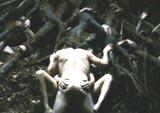 Sex in Nature 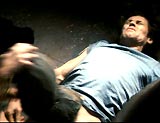 Scrotum Bashing with a Block of Wood 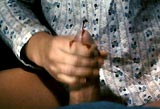 Bloody Ejaculation  Self-Abuse: Clitoridectomy 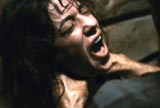 Strangulation of She 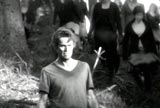 The Black-and-White Epilogue |
||||||||||||
(chronologically, by film title) Intro | Silents-1930s | 1940s-1950s | 1960-1961 | 1962-1967 | 1968-1969 1970-1971 | 1972 | 1973-1974 | 1975 | 1976-1977 | 1978 | 1979 1980-1982 | 1983-1986 | 1987-1989 | 1990-1992 | 1993-1995 | 1996-1999 2000-2002 | 2003-2005 | 2006-2009 | 2010-present |